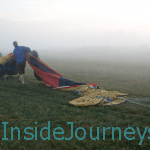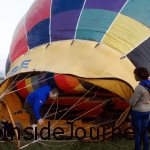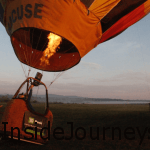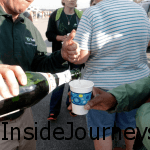Would you like to ride in a beautiful hot air balloon?
Well, I wanted to and after many years of thinking about it, I finally did when friends and I attended the Adirondack Balloon Festival at the Floyd Bennett Memorial Airport in Glens Falls, New York. Glens Falls, a small town of about 15,000, is located in the foothills of the Adirondack Mountains, north of Saratoga Springs and the Hudson River.
The festival was started 43 years ago to attract visitors to this beautiful area of Warren County. Held initially at the local community college, it moved to the airport to accommodate the estimated 30,000 who attend each day of the four-day event.
With that many people going, we were advised to get the site before 5:00 a.m. to meet our pilot. We left our hotel by 4:15 and by the time we drove the 10 minutes to the airport turnoff, there was already a line of cars waiting to get into the parking lot.
Gigantic spot lights bathed much of the tarmac and the surrounding field and the area was buzzing with activity. We followed the crowd towards the hangar where a line of people, about a half mile long, some in T-shirts and shorts, some wrapped head to toe in blankets, was waiting in the cool morning for the Big Breakfast that was scheduled to start at 5:00 a.m.
Nearby, on the fringes of the hangar, balloonists were picking out their launch spots and vendors were setting up stalls for the craft fair that takes place after the ascension.
Night receded slowly, revealing a persistent fog that covered the area like a blanket, and making us wonder whether we’d be able to go up.
At about 5:30, we made our way to a pre-arranged place to meet our pilot, Pete Griswold of Balloon Rides, LLC, and his brother, Scott of All Above Balloon Rides. Pete drove us to a wide open, grassy lot where he and his assistant, Bryan, unloaded the balloon and the basket that we’d ride in.
While Pete and Bryan unfurled and spread the 75 foot long, 250 pound balloon (also called an envelope) on the ground, I watched another ballooner as he blew air into his balloon, the first part of the process of getting the balloon aloft.
Pete asked one of my friends to hold the mouth of the balloon open then turned on a large fan that blasted up to 90,000 cubic feet of air into the envelope. It took about 30 minutes for it to be fully extended.
Pete did a flight check. Landings, he said, can be bumpy so we should squat or bend our knees so as not to injure ourselves.
Once the balloon was full of air, he lit the propane tank, righted the basket (or gondola) and told us to climb in. It’s about a 3 feet high step over the lower edge of the gondola – you can’t be dainty about it and if you’re a woman, it’s better to wear pants. Running or flat shoes are also preferable.
As we slowly – it almost didn’t feel like we were moving – and noiselessly left the ground, Pete told us that hot air ballooning started in France in 1783 when Jean-François Pilâtre de Rozier and François Laurent d’Arlandes piloted the first manned craft. Ten years later, in Philadelphia, Jean-Pierre Blanchard flew the first balloon in the U.S. Today, there are balloon festivals in nearly every state.
About 80 balloonists participated in this year’s Adirondack Balloon Festival among them, some specially shaped ones with distinctive names: Snobird Penguin, Humpty, Betty Jean Butterfly, Joelly the Baby Bee, Sunny Boy, Pandy, Stinky, the Purple People Eater and Pig Headed.
As the balloons climbed above the tarmac, the bluest of skies turned all colors of the rainbow. The sun was brilliant, the winds no more than 8 mph – perfect for flying. We glided leisurely over the airport, drifting noiselessly down, rising again as Pete lit the burner to heat the air inside the envelope, then up again. As we passed over a tree, Pete brought the balloon down so we should pick a leaf then bringing it close to another balloon for a “kiss” (bumping another balloon mid-air).
When it was time to land, Pete looked for a large cloth spread on the ground – a sign that the home owner is inviting balloons to land on his property. Each balloonist rewards the owner for his kindness with a bottle of champagne.
Once we landed, Pete and Bryan packed up the balloon and the basket, loaded them onto the truck and drove us back to the festival grounds. There, Scott, his brother opened a bottle of champagne and toasted the ride with the Balloonist Prayer.
May the winds welcome you with softness.
May the sun bless you with its warm hands.
May you fly so high and so well that God
joins you in laughter and sets you gently
back into the loving arms of Mother Earth.
The next Adirondack Balloon Festival will be September 22-25, 2016. Visit the site for a schedule of balloon events around the US.
Resources –
- CNY Balloon Rides, LLC Peter Griswold, pilot 315-263.6124
- Above All Balloon Rides, Scott Griswold, pilot 315-263-0385


































